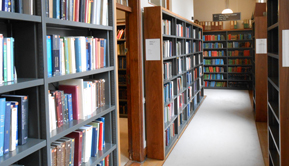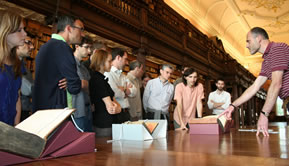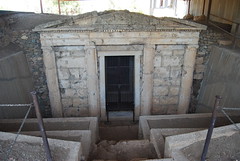Introduction
The Society is extremely fortunate to possess letters from Sir William Mitchell Ramsay, who travelled to Greece and the Ottoman Empire in the late 1800s and early 1900s with funding from the Society’s Asia Minor Exploration Fund. We have made a selection of the letters available here as digital scanned copies, however researchers are welcome to view the full collection at the Society’s office. Please contact the Executive Secretary to arrange an appointment. The majority of letters available here concern the finances of Ramsay’s trips, as well as other practical arrangements. Anyone who has taken part in fieldwork will probably recognize some of Ramsay’s difficulties with funding, travel arrangements and other practical matters.
On April 17th 1884 Ramsay writes: 'I have had to buy a new saddle: the one I brought out in 1880 is worn out; it galled the back of three horses & I had to come home on a borrowed saddle from the interior last October. I shall also have to buy two or three guns, or hire them.' The dangers of travelling in Asia Minor, and interacting with the locals is also a frequent topic. On April 17th 1884 Ramsay writes: 'I shall find it necessary to engage more men than last year: I considered last year that we ran too much risk riding to travel with fewer than two Mohammedans in my company. The feeling against England is growing steadily stronger among the Mohammedans and the necessity for caution is even greater this year than last.' The political situation is also referred to for example on March 11th 1887 when Ramsay writes about access to some documents in the Intelligence Department, to which Hirschfield sought access. He notes that 'those which he wishes relate to a frontier wh. [sic] will be of the utmost military importance in the next war, I think.' Ramsay also writes on the problems of acquiring the necessary permits for taking 'photographs & impressions of ancient monuments' in the letter to Macmillan dated May 8th 1890.The same topic is discussed in his letter to Bywater dated December 5Th 1882: 'In my journey last autumn I was much troubled from the want of a firman; on two occasions I narrowly escaped being turned back, and in general I got on only by making the servants tell every one that I had a firman. In this autumn a decree has been issued by the Turkish government that any traveller taking notes & making plans of the country is to be arrested as a spy.' Several notable characters are referred to among the letters. Ramsay discusses helping Mommsen acquire an inscription from Orcistus in 1884, for which he was going to be reimbursed by the Prussian government (see letters dated May 23rd 1884 and May 27th 1886. See also CIL III 352; CIL III S 7000; T. Mommsen, Gesammelte Schriften 5, 1908, 540-551, W. M. Ramsay, ‘Note on JHS 1937, p.1, JHS57, 1937, 247). In a letter dated December 15, 1888, Ramsay is discussing travels with A. C. Sayce, and notes some disagreement over the comfort level of travel: 'Sayce wants a more expensive & luxurious style; but I shall propose to him that he must stand any extra expense he insists on.' In the final letter dated May 10th 1904 Ramsay discusses his attempt at training Hasluck as a successor, and laments his unwillingness to endure the difficulties of travel. We have also scanned Hasluck’s letter, which was enclosed in Ramsay’s letter to Macmillan. Ramsay writes: 'The enclosed is a great disappointment. I have always been specially anxious to get a promising young Cambridge man started in Asia Minor work; & I was particularly pleased with what I saw in Hasluck. I quite appreciate the wearingess & low spirits that supervene at the end of an excursion: & he seems to have suffered during his five (or four) weeks in the Cyzicus districts.' However, Ramsay need not have worried so, as Hasluck later became the librarian and assistant director of the British School at Athens.
Letters to Macmillan
30.09.1881
03.12.1881
29.12.1881
30.12.1881
30.12.1881 (private)
31.01.1882
18.03.1882
19.05.1882
03.08.1883 (Lady Ramsay)
20.08.1883
21.11.1883
17.04.1884
23.05.1884
15.08.1884
15.08.1884 2
13.12.1884
05.02.1886
11.02.1886
27.02.1886
17.03.1886
27.05.1886
06.06.1886
11.03.1887
18.05.1887
24.11.1888
15.12.1888
24.01.1890
08.05.1890
21.01.1891
04.02.1891
24.03.1901
05.05.1904
10.05.1904
Letters to Others
Letter to Newton undated
Letter to Newton 18.10.1881
Reply from Newton to letter dated 18.10.1881
Letter to Mr Bywater 05.12.1882
Letter to Henry Pelham 17.05.1887
Letter to Henry Pelham 19.05.1887
Letter to Henry Pelham 09.10.1897
Letter to Henry Pelham 05.11.?
Letter from Hasluck to Ramsay 05.05.1904 (enclosed in letter to Macmillan 10.05.1904)
Related Papers
Letters from Arthur Cadogan Blunt to Macmillan
25.09.1881
undated but with paper dated 26.09.1881
03.12 Smyrna
Sir Philip W Currie, Foreign Office 04.12.1889
Sir Philip W Currie, Foreign Office 08.05.1890
James Fergusson 15.08.1883
James Fergusson 21.03.1884
James Fergusson 25.03.1884
James Fergusson 20.04.1884
D.B. Monro 03.01.1882
D.B. Monro 18.01.1882
D.B. Monro 16.08.1883
D.B. Monro 22.08.1883
D.B. Monro 03.09.1884
D.B. Monro 03.05.1887
D.B. Monro (also signed by Henry Pelham) 04.05.1887
Recommendations for Sir W. M. Ramsay
Heinrich Kiepert, Berlin 15.01.1884
Theodor Mommsen, Charlottenburg 01.02.1884
Account of the first 50 years of the Society (1879-1929)[/wpcol_1half_end]
Further Reading
Ramsay published several articles on discoveries made during his travels:
‘Newly discovered sites near Smyrna’, JHS 1 (1880), 63-74.
‘Contributions to the history of Southern Aeolis (part I)’, 44-54, Contributions to the history of Southern Aeolis (part II), 271 -308, both in JHS 2 (1881).
‘Studies in Asia Minor’, JHS 3 (1882), 1-68.
‘Inscriptions from Nacoleia’, JHS 3 (1883), 119-127.
‘Some Phrygian monuments’, JHS 3 (1883), 257-263.
‘Metropolitanus Campus’, JHS 4 (1883), 53-72.
‘The Graeco-Roman Civilisation in Pisidia’, JHS 4 (1883), 23-45.
‘The cities and bishoprics of Phrygia’, JHS 4 (1883), 370-436.
‘Sepulchral customs in ancient Phrygia’, JHS 5 (1884), 241-262.
‘The cities and bishoprics of Phrygia II’, JHS 8 (1887), 461-519.
‘A study of Phrygian Art (Part 1)’, JHS 9 (1888), 350-382.
‘Study of Phrygian art Art (Part 1)’, JHS 9 (1888), 350-382.
‘Study of Phrygian art Art (Part 2)’, JHS 10 (1889), 147-189.
‘Artemis-Leto and Apollo-Lairbenos’, JHS 10 (1889), 216-230.
‘Topography and epigraphy of Nova Isaura’, JHS 25 (1905), 163-180.
‘Note on JHS 1937, p.1’, JHS 57 (1937), 247.
In addition, his daughter published an article in JHS:
A. M. Ramsay, ‘The Early Christian Art of Isaura Nova’, JHS 24 (1904), 260-292.
J. R. S. Sterrett, who traveled with Ramsay in 1884 (see letters dated 21.11.1883 and 17.04.1884) published his results in:
‘Inscriptions of Tralleis’, Papers of the American School of Classical Studies at Athens 1, 1882-1883, Boston (1885), 91-120.
You can also find a proposal for his trip in the archive of the American School of Classical Studies at Athens.
General Bibliography
D. W. J. Gill, Sifting the Soil of Greece: the Early Years of the British School at Athens (1886-1919). Bulletin of the Institute of Classical Studies, suppl. 111. London: Institute of Classical Studies, 2011.
See also the BSA history blog:
https://bsahistory.blogspot.com/2008/01/scotland-and-bsa.html
https://bsahistory.blogspot.com/2008/03/asia-minor-exploration-fund-funding.html
D. Challis, From the Harpy Tomb to the Wonders of Ephesus: British archaeologists in the Ottoman Empire 1840-1880. London 2008.
D. W. J. Gill, ‘The British School at Athens and archaeological research in the late Ottoman Empire’, in D. Shankland (ed), Archaeology, anthropology and heritage in the Balkans and Anatolia: the life and times of F.W. Hasluck, 1878-1920, vol. 1, Istanbul 2004, 223-255.









